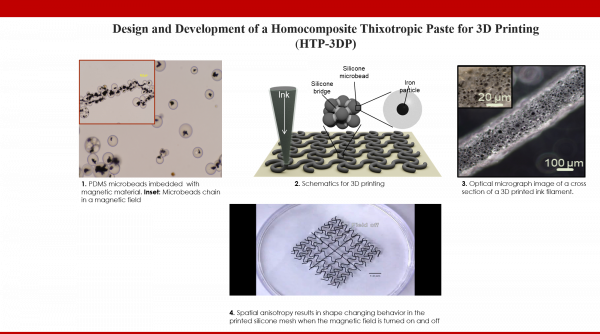Lilian Okello
| lbokello@ncsu.edu M.S. Chemical Engineering, 2009 City University of New York City College B.S. Chemical Engineering, 2005 City University of New York City College |  |
Research Focus:
My research involves designing and developing various homocomposite thixotropic capillary inks for 3D printing. The material of choice so far has been poly-dimethyl siloxane (PDMS) because it is biocompatible and hence holds potential in 3D printing structures with biomedical applications, ranging from bio scaffolds to artificial organs. Its soft nature also offers potential applications in soft robotics. However, the challenge posed by PDMS is that it is liquid at room temperature and thus cannot be printed as is. Fillers e.g. fiber glass, glass microbeads or metallic particles have often been added into the polymer matrix to increase its viscosity enough to allow printing. Consequently, this has the disadvantage of hardening the final cured product and thus unsuitable for applications that require the material to be stretchable and bendable. We have solved this problem by designing a soft, printable PDMS polymer matrix by ensuring that the ink has only one component without the need for fillers.
The work involves synthesizing PDMS microbeads via emulsification of liquid PDMS in a water/PVA mixture at high shear. The size of the microbeads is customizable by controlling the sheer rate. The result is a relatively monodispersed batch of cross-linked and cured spherical PDMS microbeads. To fabricate the ink, these microbeads are then dispersed into uncured PDMS liquid precursor; hence the title “homocomposite”, as both the cured microbeads and the capillary bridging liquid are of the same material. The bridging liquid polymer precursor acts much like water that holds sand granules together by capillary force in a sandcastle. The liquid precursor (LP) is cross-linked at a ratio that has been tested to give rise to ink / paste with yield stress and therefore can reduce its viscosity and soften; thus allowing its extrusion under pressure from the nozzle of 3D printer. The resulting paste immediately becomes firm, regains and maintains a solid shape after extrusion, hence exhibiting thixotropic behavior.
The current phase of my research now focuses on designing ink the same way, but imbedding magnetic material into the microbeads during the emulsification step. The resulting paste is still homocomposite, as the magnetic material is ‘frozen’ inside the microbeads and does not contribute to the microbeads/liquid interaction. The contact angle and capillary force between the microbeads and the liquid precursor is not altered. We believe that adding magnetic material into the ink opens up new avenues to a wider range of applications. This can enable us to design 3D printable bio-scaffolds for growing cells in an environment that can be tuned to mimic normal heart or lung contraction and relaxation. This can be achieved by manipulating the current and varying the strength of the magnetic field to result in the desired actuation. Below are figures that illustrate the work.

